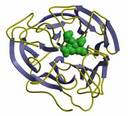|
OFFICE OF TECHNOLOGY ASSESSMENT (OTA)
Health Care Technology and Its Assessment in Eight Countries,
1995.
General Facts
1. In 1990 life expectancy in the U.S. was 71.8 years for
men and 78.8 for women, among the lowest of the developed
countries.
2. The 1990 infant mortality rate was 9.2 per 1,000 live
births. This was in the bottom half of the distribution
among all developed countries. (OTA comments on the frustration
of poor statistics and high healthcare spending.)
3. Health status is correlated with socioeconomic status.
4. Healthcare is not universal.
5. Healthcare is based on the free market system with no
fixed budget or limitations on expansion.
6. Healthcare accounts for 14% of the U.S. GNP, which was
over $800 billion in 1993.
7. The federal government does no central planning. It
is the major purchaser of health care for older people and
some poor people.
8. Americans have a lower level of satisfaction with their
healthcare system than people in other developed countries.
9. U.S. medicine specializes in expensive medical technology.
Some major U.S. cities have more MRI scanners than most
countries.
10. Huge public and private investment in medical research
and pharmaceutical development drives this "technological
arms race."
11. Any efforts to restrain technological developments
in healthcare are opposed by policy makers concerned about
negative impacts on medical-technology industries.
Hospitals
12. In 1990 there were: 5,480 acute-care hospitals, 880
specialty hospitals (psychiatric, long-term care, rehab)
and 340 federal hospitals (military, vets and Native Americans)
providing 2.7 hospitals per 100,000 population.
13. In 1990 the average length of stay for an annual 33
million admissions was 9.2 days. Bed occupancy rate was
66%. Lengths of stay were shorter and admission rates lower
than other countries.
14. In 1990 there were 615,000 physicians, 2.4 per 1,000;
33% were primary care (family medicine, internal medicine,
and pediatrics) and 67% were specialists.
15. In 1991 government-run healthcare spending was $81
billion.
16. Total healthcare spending was $752 billion in 1991,
an increase from $70 billion in 1950. Spending grew five-fold
per capita.
17. Reasons for increased healthcare spending:
a. The high cost of defensive medicine, with an escalation
in services solely to avoid malpractice litigation.
b. U.S. healthcare based on defensive medicine costs
nearly $45 billion per year, or about 5% of total healthcare
spending, according to one source.
c. The availability and use of new medical technologies
have contributed the most to increased healthcare spending,
argue many analysts. OTA admits that these costs are impossible
to quantify.
18. The reasons government attempts to control healthcare
costs have failed:
a. Market incentive and profit-motive involvement in
the financing and organization of healthcare including
private insurance, hospital system, physician services,
and drug and medical device industries.
b. Expansion is the goal of free enterprise.
Health-Related Research and Development
19. The U.S. spends more than any other country on R &
D.
20. $9.2 billion was spent in 1989 by the federal government;
U.S. industries spent an additional $9.4 billion.
21. There was a 50% rise in total national R & D expenditures
between 1983 and 1992.
22. NIH receives about half of the government funding.
23. NIH spent more on basic research ($4.1 billion in 1989)
than for clinical trials of medical treatments on humans
($519 million in 1989).
24. Most of the trials evaluate new cancer treatment protocols
and new treatments for complications of AIDS and do not
study existing treatments, even though the effectiveness
of many of them is unknown and questioned.
25. The NIH in 1990 had just begun to do meta-analysis
and cost-effectiveness analysis.
Pharmaceutical and Medical Device Industry
26. About two-thirds of the industry's $9.4 billion budget
went to drug research; the remaining one-third was spent
by device manufacturers.
27. In addition to R & D, the medical industry spent
24% of total sales on promoting their products and only
15% of total sales on development.
28. Total marketing expenses in 1990 were over $5 billion.
29. Many products provide no benefit over existing products.
30. Public and private healthcare consumers buy these products.
31. If healthcare spending is perceived as a problem, a
highly profitable drug industry exacerbates the problem.
Controlling Health Care Technology
32. The FDA ensures the safety and efficacy of drugs, biologics,
and medical devices.
33. The FDA does not consider costs of therapy.
34. The FDA does not consider the effectiveness of a therapy.
35. The FDA does not compare a product to currently marketed
products
36. The FDA does not consider non-drug alternatives for
a given clinical problem.
37. Drug development costs $200 million to bring a new
drug to market. AIDS-drug interest groups forced new regulations
that speed up the approval process.
38. Such drugs should be subject to greater post-marketing
surveillance requirements. But as of 1995 these provisions
had not yet come into play.
39. Many argue that reductions in the pre-approval testing
of drugs opens the possibility of significant undiscovered
toxicities.
Health Care Technology Assessment
40. Failure to evaluate technology was a focus of a 1978
report from OTA with examples of many common medical practices
supported by limited published data. (10-20%)
41. In 1978 congress created the National Center for Health
Care Technology (NCHCT) to advise Medicare and Medicaid.
42. With an annual budget of $4 million NCHCT published
three broad assessments of high-priority technologies and
made about 75 coverage recommendations to Medicare.
43. NCHCT was put out of business by Congress in 1981-a
political casualty. The medical profession opposed it from
the beginning. The AMA testified before Congress in 1981
that "clinical policy analysis and judgments are better
made-and are being responsibly made-within the medical profession.
Assessing risks and costs, as well as benefits, has been
central to the exercise of good medical judgment for decades."
44. The medical device lobby also opposed government oversight
by NCHCT.
Examples of Lack of Proper Management of HealthCare
1. Treatments for Coronary Artery Disease
45. Since the early 1970's the number of coronary artery-bypass
surgeries (CABGS) has risen rapidly without government regulation
and without clinical trials.
46. Angioplasty for single vessel disease was introduced
in 1978. The first published trial of angioplasty versus
medical treatment was in 1992.
47. Angioplasty did not cut down on the number of CABGS
as was promoted.
48. Both procedures increase in number every year as the
patient population grows older and sicker.
49. Rates of use are higher in white patients, in private
insurance patients, and there is great variation in different
geographic regions. Such facts imply that use of these procedures
is based on non-clinical factors.
50. At the time of this report, 1995, the NIH consensus
program had not assessed CABGS since 1980 and had never
assessed angioplasty.
51. RAND researchers evaluated CABGS in New York in 1990.
They reviewed 1,300 procedures and found 2% were inappropriate,
90% appropriate, and 7% uncertain. For 1,300 angioplasties,
4% were inappropriate and 38% uncertain. Using RAND methodologies
a panel of British physicians rated twice as many procedures
"inappropriate" as did a U.S. panel rating the
same clinical cases. The New York numbers are in question
because New York State limits the number of surgery centers,
and the per-capita supply of cardiac surgeons in New York
is about one-half the national average.
52. The estimated five-year cost is $33,000 for angioplasty
and $40,000 for CABGS. So, angioplasty did not lower costs.
This was because of high failure rates of angioplasty.
2. Computed Tomography CT
53. The first CT scanner in the U.S. was installed at the
Mayo Clinic in 1973. In 1992 the number of operational CT
scanners was 6,060. By comparison, in 1993 there were 216
CT units in Canada.
54. There is little information available on how CT scan
improves or affects patient outcome.
55. In some institutions up to 90% of scans performed were
negative.
56. Approval by the FDA was not required for CT scanners.
No evidence of safety or efficacy was required.
3. MRI
57. The first MRI was introduced in 1978 in Great Britain;
the first U.S. scanner in 1980. By 1988 there were 1,230
units; by 1992 between 2,800 and 3,000.
58. A definitive review published in 1994 found less than
30 studies out of 5,000 that were prospective comparisons
of diagnostic accuracy or therapeutic choice.
59. American College of Physicians assessed MRI studies
and rated 13 out of 17 trials as "weak" - meaning
the absence of any studies on therapeutic impact or patient
outcomes.
60. The OAT concludes that, "It is evident that hospitals,
physician-entrepreneurs, and medical device manufacturers
have approached MRI and CT as commodities with high-profit
potential, and decision-making on the acquisition and use
of these procedures has been highly influenced by this approach.
Clinical evaluation, appropriate patient selection, and
matching supply to legitimate demand might be viewed as
secondary forces."
4. Laparoscopic Surgery
61. Laparoscopic cholecystectomy was introduced at a professional
surgical society meeting in late 1989. In 1992, five years
after introduction, 85% of all cholecystectomies were performed
laparoscopically.
62. There was an associated increase of 30% in the number
of cholecystectomies performed.
63. Because of the increased volume of gall bladder operations,
the total costs increased 11.4% between 1988 and 1992, in
spite of a 25.1% drop in the average cost per surgery.
64. The mortality rate for gall bladder surgeries also
did not decline as a result of the lower risk because so
many more were performed.
65. When studies were finally done on completed cases,
the results showed that laparoscopic cholecystectomy was
associated with reduced in-patient duration, decreased pain,
and shorter period of restricted activity. But there were
increased rates of bile duct and major vessel injuries and
a suggestion that these rates were worse for people with
acute cholecystitis. There were still no clinical trials
to clarify this issue.
66. Patient demand, fueled by substantial media attention,
was a major force in promoting rapid adoption.
67. The video, which introduced the procedure in 1989,
was produced by the major manufacturer of laparoscopic equipment.
68. Doctors were given two-day training seminars before
performing the surgery on patients.
Infant Mortality
69. In 1990 the U.S. ranked twenty-fourth in infant mortality
out of 38 developed countries with a rate of 9.2 deaths
per 1,000 live births.
70. U.S. black infant mortality is 18.6 per 1,000 live
births and 8.8 for whites.
Screening for Breast Cancer
71. There has always been a debate over mammography screening
in women under 50.
72. In 1992 the Canadian National Breast Cancer Study of
50,000 women showed that mammography had no effect on mortality
for younger women, aged 40-50.
73. The National Cancer Institute (NCI) refused to change
its recommendations on mammography.
74. The American Cancer Society decided to wait for more
studies on mammography.
75. Then, in December 1993 NCI announced that women over
50 should have routine screening every one to two years
but younger women would have no benefit from having mammography.
Summary
76. The OTA concluded that, "There are no mechanisms
in place to limit dissemination of technologies regardless
of their clinical value."
Shortly after this report, the OTA was disbanded.
|





